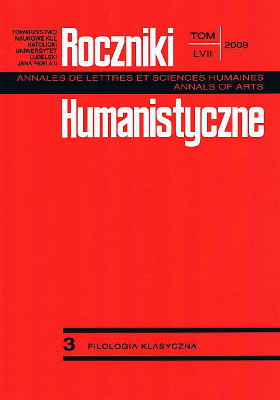Kosmogonia i teogonia w papirusie z Derveni
Abstrakt
This article concerns the Derveni Papyrus – precisely, the cosmogony and theogony which the Papyrus includes. It is mainly based on the foreign-language literature (especially English) gathered and listed in the Bibliography. The main aim of the article is to present and approximate the status quaestionis of the Derveni text in the way which the article title expresses.
The Derveni Papyrus is dated – approximately – to the fourth century BC. Today it is being examined against the background of the ancient exegesis history. This dual text which reveals some connections with the Orphic religious orientation – at least by the fact of speaking about Orpheus as an authority, or describing in its first part (col. I-VI) probably an Orphic religious rite – still causes many difficulties to the scholars. The problem of the authorship which determining would definitely be helpful in the proper interpretation of its purpose and meaning remains unsolved so far. Not only is the Derveni text dual in its structure, but also double-plane. The first plane is one of the Orphic theogonies. It is comprised in the poem ascribed to Orpheus which is quoted in the Derveni text. The second plane concerns the cosmogonic exegesis. The sum of the planes gives the reader a picture of the universe in the shape the Derveni author – who probably stayed also under the influence of the presocratic philosophy – must have ‘seen’ it. The cosmogony which we can read from the exegesis sees the prime mover that plays an active part in the universe in the divine Mind/air. In this cosmogony the beginning of all of the processes in the world is dependent on the moment when the airy Νοῦς creates the Sun.
This article is definitely not exhaustive, since it is only a brief sketch of all of the information that we can find in the foreign language literature on the Derveni Papyrus. Nevertheless, it is supposed to be synthetic, as far as it is possible, and fairly objective.
Bibliografia
Bernabé A.: Poetae epici graeci. Testimonia et fragmenta, Pars II: Orphicorum et orphicissimilium. Testimonia et fragmenta, Fasciculus 1, Monachii et Lipsiae 2004.
Betegh G.: The Derveni Papyrus. Cosmology, Theology and Interpretation, Cambridge 2004.
Burkert W.: Orpheus und die Vorsokratiker. Bemerkungen zum Derveni-Papyrus und zur pythagoreischen Zahlenlehre, „Antike und Abendland” 14 (1968), s. 93-114.
Burkert W.: The logic of cosmogony, [w:] From Myth to Reason? Studies in the Development of Greek Thought, ed. R. Buxton, Oxford 1999, s. 87-106.
Diels H. A., Kranz W. (Hrsg.): Die Fragmente der Vorsokratiker, Berlin–Charlottenburg 19568.
Graves R.: Mity greckie, Warszawa 1974.
Janko R.: The Derveni Papyrus (Diagoras of Melos, Apopyrgizontes Logoi?): A New Translation, „Classical Philology” 96 (2001), s. 1-32.
Janko R.: The Derveni Papyrus: an Interim Text, „Zeitschrift für Papyrologie und Epigraphik” 141 (2002), s. 1-62.
Janko R.: The Physicist as Hierophant: Aristophanes, Socrates and the Authorship of the Derveni Papyrus, „Zeitschrift für Papyrologie und Epigraphik” 118 (1997), s. 61-94.
Kapsomenos S. G.: Der Papyrus von Derveni. Ein Kommentar zur orphischen Theogonie, „Gnomon” 35 (1963), s. 222-223.
Kern O.: Orphicorum Fragmenta, Berolini 1922.
Keuls E. [rec.:] M. Schmidt, A. D. Trendall, A. Cambitoglou, Eine Gruppe apulischer Grabvasen in Basel. Studien zu Gehalt und Form der unteritalischen Sepulkralkunst, „American Journal of Archaeology” 81 (1977), no. 3, s. 403-404.
Kirk G. S., Raven J. E., Schofield M.: The Presocratic Philosophers: a critical history with a selection of texts, Cambridge 1983.
Kouremenos T., Parássoglou G. M., Tsantsanoglou K.: The Derveni Papyrus, edited with Introduction and Commentary, Firenze 2006.
Krokiewicz A.: Studia orfickie, Warszawa 1947.
Kulig K.: Papirus z Derveni (przekład), „Studia Antyczne i Mediewistyczne” 2005, nr 3 [38], s. 5-17.
Laks A.: Between Religion and Philosophy: the Function of Allegory in the Derveni Papyrus, „Phronesis” 42 (1997), s. 121-142.
Laks A., Most G. W.: Studies on the Derveni Papyrus, Oxford 1997.
Most G. W.: The Fire Next Time. Cosmology, Allegoresis, and Salvation in the Derveni Papyrus, „The Journal of Hellenic Studies” 117 (1997), s. 117-135.
Mouraviev S. N.: The Heraclitean Fragment of the Derveni Papyrus, „Zeitschrift für Papyrologie und Epigraphik” 61 (1985), s. 131.
Nilsson M. P.: Early Orphism and Kindred Religious Movements, „The Harvard Theological Review” 28 (1935), s. 181-230.
Picard C.: Après la lecture – encore partielle – du Papyrus de Derveni…, [w:] Mélanges Carcopino, Paris 1966, s. 737-746.
Powszechna Encyklopedia Filozofii, Lublin 2000-.
Reale G.: Historia filozofii starożytnej, t. I: Od początków do Sokratesa, przeł. E. I. Zieliński, Lublin 2005.
Rusten J. S.: Interim Notes on the Papyrus from Derveni, „Harvard Studies in Classical Philology” 89 (1985), s. 121-140.
Seaford R.: Immortality, Salvation, and the Elements, „Harvard Studies in Classical Philology” 90 (1986), s. 1-26.
Sider D.: Heraclitus B3 and 94 in the Derveni Papyrus, „Zeitschrift für Papyrologie und Epigraphik” 69 (1987), s. 225.
The Oxford Classical Dictionary, Third Edition Revised, ed. S. Hornblower and A. Spawforth, Oxford 1996.
Torjussen S., Phanes and Dionysos in the Derveni Theogony, „Symbolae Osloenses” 80 (2005), s. 7-22.
West M. L.: The Orphic Poems, Oxford 1983.
Copyright (c) 2009 Roczniki Humanistyczne

Utwór dostępny jest na licencji Creative Commons Uznanie autorstwa – Użycie niekomercyjne – Bez utworów zależnych 4.0 Międzynarodowe.





